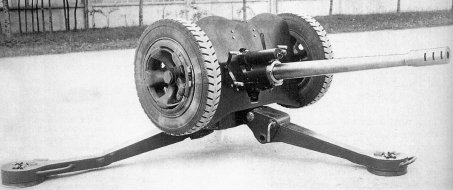The 47mm SA 39 TAZ was a more involved development of the mie 1937 47-mm (1.85-in) anti-tank gun, which had a conventional wheeled carriage. The mie 1939 used a complex all-round-traverse carriage, although some were produced with normal wheeled carriages.
The best of the French anti-tank guns was the Canon de 46 antichar SA mie 1937, a design that originated with the Atelier de Puteaux, It was developed in a great hurry and introduced into service once the French army had been provided with indications of the armour thickness of the German PzKpfw IV tank, Considering the rush with which the mie 1937 was developed it was an excellent anti-tank weapon and one of the best in service anywhere in 1939. The main trouble for the French army was that there were not enough of them to hand during the events of May 1940.
The mie 1937 was introduced into limited service in 1938, but the main production run was in 1939. The type was issued to French artillery batteries operating in support of army divisions and brigades, and was operated in batteries, each battery having six guns. The equipments were usually towed into action behind Somua halftracks, and in action their low outlines made them easy to conceal. They were capable of penetrating the armour of any tank likely to be put into action against them. In appearance the mie 1937 looked powerful and low. The gun had a barrel nearly 2.5 m (8 ft 2 in) long, and the carriage used pressed steel wheels with solid rubber rims, On top of the shield there was the fashionable corrugated outline to break up the shape.
Along with production of the towed anti-tank model of the mie 1937 went production of a very similar gun intended for use in the permanent fortifications of the Maginot Line. This version lacked the carriage of the towed version and instead was swung into its firing position (through specially constructed firing slits) suspended from overhead rails. In 1939 there appeared a slightly revised version of the mie 1937 known as the Canon de 47 antichar SA mie 1937/39, but the detailed differences between these two guns were slight. In 1940 there appeared the Canon de 47 antichar SA mie 1939 and this was a quite different weapon. It used the gun of the mie 1937, but mounted on a new tripod carriage so arranged that once it was emplaced the gun could be swung through 360° to fire against targets appearing from any point of the compass, To emplace the gun a forward leg of the tripod was swung down, the trail legs were spread and the wheels were then raised to positions on each side of the shield. This futuristic concept was doomed never to see service, for the events of May 1940 intervened before production could start.
May and June 1940 saw the bulk of the French mie 1937s pass into German hands, The Germans regarded the mie 1937 very highly, for many of their tanks had suffered from the striking power of the gun, and after 1940 they used the mie 1937 widely as the 4.7-cm Pak 141(f); the gun was still in service when the Allies landed in Normandy in June 1944. Before that the Germans had also used the mie 1937 to arm many of their early Panzerjäger (tank hunter) conversions produced by removing the turrets from captured French tanks and replacing them with anti-tank guns on open mountings.
Specification Canon de 47 antichar SA mie 1937 Calibre: 47 mm (1.85 in) Length of barrel: 2.49 m (8 ft 2 in) Weight: travelling 1090 kg (2,403 lb) and in action 1050 kg (2,315 lb) Traverse: 68° Elevation:-13° to+ 16.5° Muzzle velocity: 855 m (2,805 ft) per second Maximum range: 6500 m (7,110 yards) Projectile weight: 1.725 kg (3.8 lb) Armour penetration: 80 mm (3.15 in) at 200 m (220 yards)
